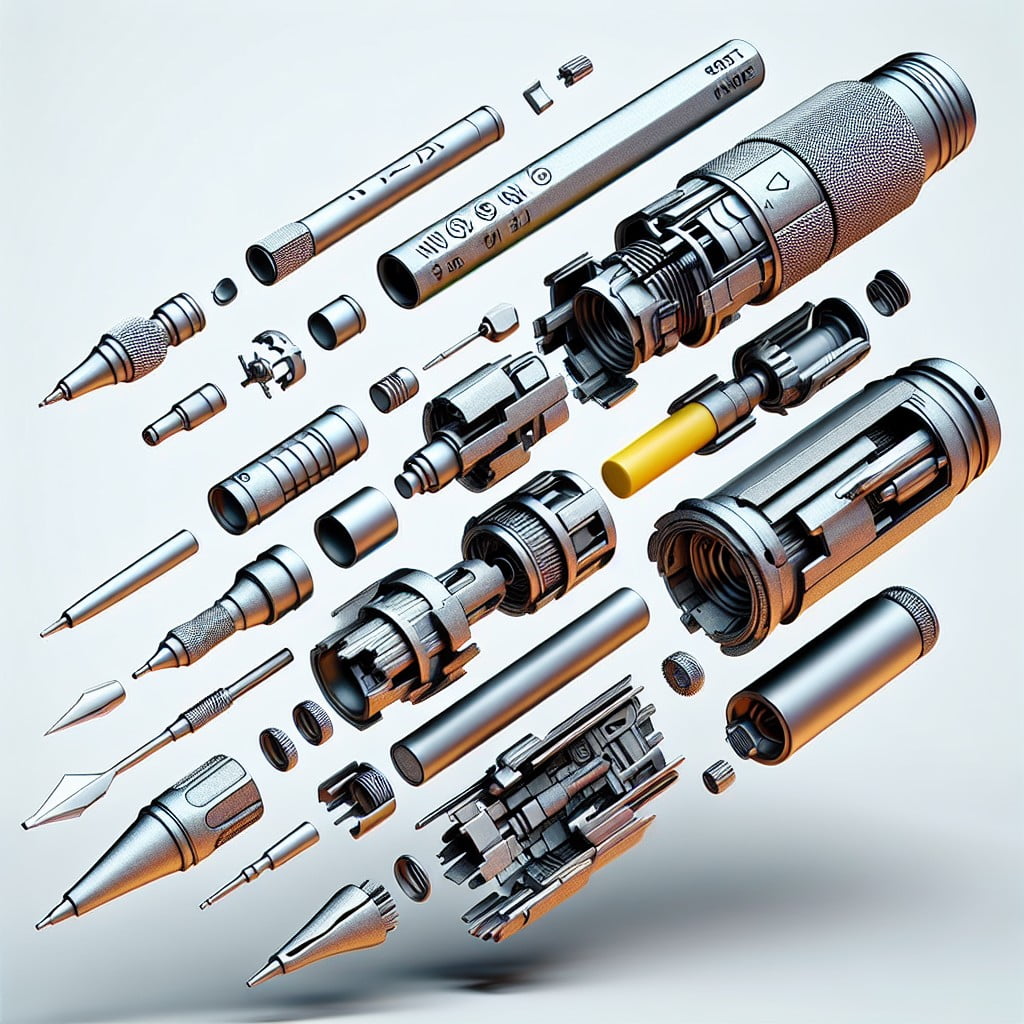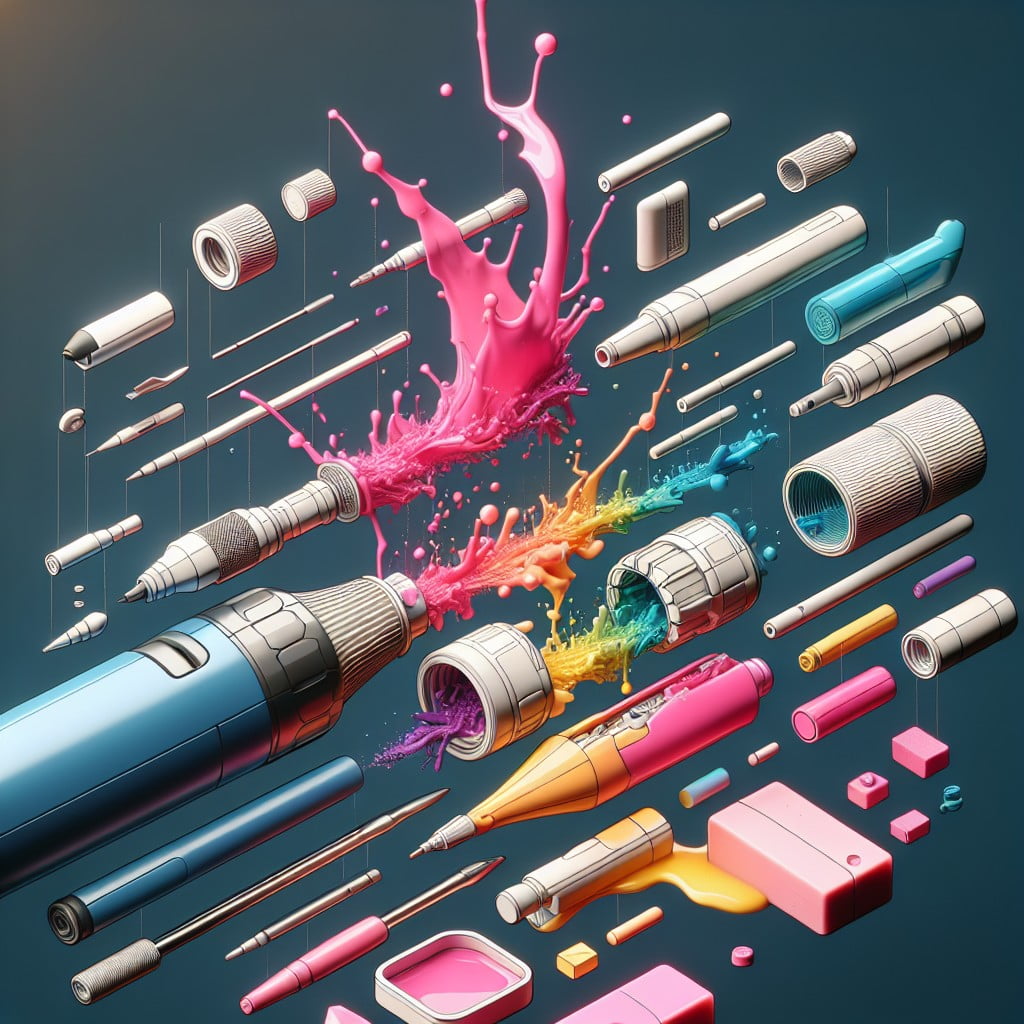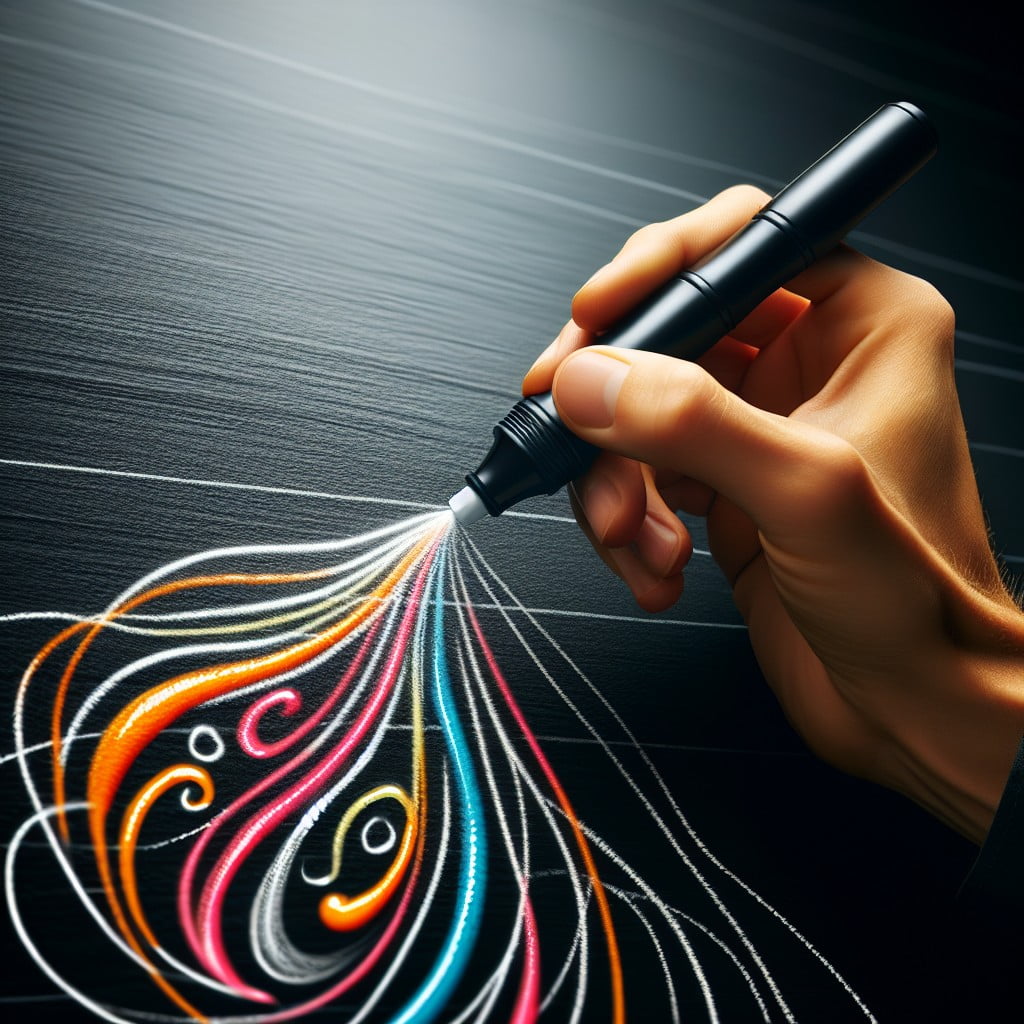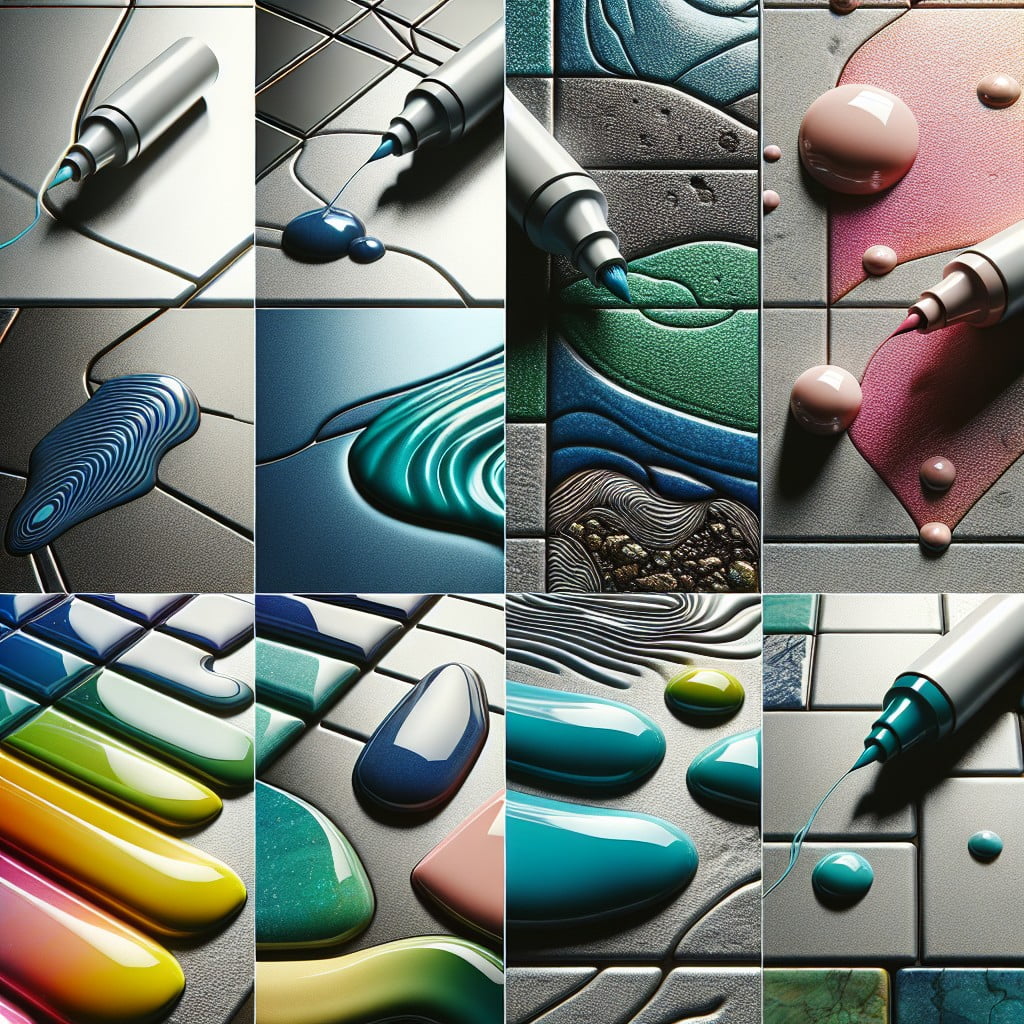Last updated on
Discover the versatility of liquid chalk pens because their various benefits range from vibrant visuals to easy cleanup, making them an impressive addition to any artistic toolkit.
Key takeaways:
- Liquid chalk pens are versatile and offer vibrant visuals.
- The pens have a water-based solution mixed with powdered chalk.
- They are user-friendly with smooth flow and reversible tips.
- Liquid chalk pens are ideal for menu boards, classrooms, and retail displays.
- Consider tip size, color vibrancy, and surface compatibility when choosing.
Composition and Features of Liquid Chalk Pens

Liquid chalk pens contain a water-based solution mixed with powdered chalk and a pigment for color. Once applied, the liquid dries quickly, leaving a chalk-like appearance that is smudge-proof and vibrant.
Their user-friendly push-down tip releases the liquid chalk smoothly, allowing for precise and clean lines. These pens come in a variety of tip sizes, enabling detailed work on small surfaces or bold writing that’s visible from a distance.
Many are also equipped with reversible tips, offering both a bullet and chisel option in one pen. The ink can withstand the elements but is easily erasable on non-porous surfaces with a damp cloth, making them reusable and versatile.
How Liquid Chalk Pens Work

Liquid chalk pens are a modern twist on traditional chalk, employing a water-based solution that carries pigment and releases it through a porous nib when applied to a surface. Inside the pen, the liquid formula is typically a mixture of calcium carbonate and a solvent that allows for smooth flow and easy application.
Upon pressing the nib against a surface, the ink is dispensed, often starting as a liquid and then drying into a chalk-like state. This transformation happens as the solvent evaporates, leaving behind the colored pigment for a vibrant and crisp display.
Thanks to their design, these pens can create fine lines and detailed artwork, making them a perfect tool for both professional artists and enthusiasts alike. The reversible tips found on some models enhance versatility, offering both fine and broad stroke options.
To get started, a simple shake of the pen and a gentle press primes the nib, after which the pen is ready to use. The ease of flow control ensures that you can achieve both precision and coverage according to the pressure applied.
Remember that while they work on various non-porous surfaces, they’re not suitable for porous materials which could absorb the ink and negate the easy-clean aspect that makes liquid chalk pens so appealing.
Benefits of Using Liquid Chalk Pens

Liquid chalk pens offer a variety of advantages over traditional chalk. With vibrant colors, they produce bold and opaque lines that are easily visible, enhancing readability from a distance. These pens reduce the dust commonly associated with traditional chalk, making them ideal for users with respiratory sensitivities and keeping the work environment cleaner.
Added convenience comes from their quick-drying nature, which minimizes smudging and makes them a favorite for both meticulous artists and busy teachers. The water-based formula allows for easy clean-up, requiring just a damp cloth to remove markings, thus simplifying changes on signage or artwork.
Moreover, liquid chalk pens are often refillable, offering long-term cost savings and reducing waste. Their reversible tips, equipped with a chisel on one end and a bullet point on the other, provide versatility for various writing or drawing needs, fostering creativity across multiple surfaces, from chalkboards to glass.
Applications and Surfaces Suitable for Liquid Chalk Pens

Liquid chalk pens are incredibly versatile, catering to both artistic endeavors and practical displays. Their vivid colors and ease of use make them a favorite for:
- Menu boards in cafes and restaurants, where daily specials require frequent updates.
- Classroom settings, where teachers use them on blackboards and whiteboards for legible and dust-free writing.
- Home decoration, ideal for labeling jars in the kitchen or creating personalized messages on mirrors.
- Retail displays, as they can be used to design eye-catching signs on glass and glossy surfaces.
- Event planning for customizing signs and seating charts, adding a professional touch to special occasions.
- Vehicle windows, often seen in car dealerships to feature prices or promotions, as the ink is resistant to light rain but removable.
Before application, ensure that the surface is non-porous and clean for the best adherence and visibility of the liquid chalk.
Choosing the Right Liquid Chalk Pen for Your Project
Selecting the appropriate liquid chalk pen hinges on several factors:
- Tip Size: Assess the level of detail your project requires. Fine tips are ideal for intricate designs and writing, while broader tips suit bold and eye-catching displays.
- Color Vibrancy: Decide on colors that stand out against your chosen surface. More vibrant colors ensure your message is noticeable and legible.
- Surface Compatibility: Ensure the pen is suited for the surface you plan to write on, whether it’s glass, whiteboards, or another non-porous material.
- Erasability: Consider whether you need the markings to be temporary or permanent. Some pens are designed to wipe away easily with a damp cloth, while others might require a cleaning solution.
- Drying Time: Look for pens that dry quickly to avoid smudging, especially if you’re working on vertical surfaces or if the content will be touched or handled.
- Quality and Brand Reputation: Opt for brands with positive reviews and ratings, as they’re more likely to provide reliable, high-quality pens.
- Ink Longevity: Check for pens with ink that doesn’t dry out quickly, particularly if you plan to use them over an extended period.
By taking these points into account, you’re well on your way to picking a liquid chalk pen that aligns with your creative or professional needs.
Differences Between Liquid Chalk Pens and Traditional Chalk
Traditional chalk, made from natural limestone or calcium sulfate, tends to produce dust that can be allergenic and messy. In contrast, liquid chalk pens contain a water-based solution mixed with a pigment and a small amount of alcohol, which evaporates once the ink dries, leaving a vibrant, matte finish. This liquid formulation means substantially less dust production, making it a favorite for people with dust sensitivities.
Liquid chalk also offers a more precise application compared to the broader strokes of traditional chalk sticks. With their fine tips, liquid chalk pens enable detailed work and fine lettering, ideal for intricate designs or writing on smaller surfaces like labels and jars.
When it comes to durability, markings from liquid chalk pens are more resistant to smudging and accidental erasing. However, they are still easy to remove with a damp cloth, while traditional chalk may require dusting or a chalkboard eraser, which can leave streaks and require more rigorous cleaning.
With liquid chalk pens, the user gains control over the opacity of their lines. Apply lightly for a semi-transparent look or go over the same line for a more opaque appearance, a flexibility not available with traditional chalk which has a consistently opaque output regardless of pressure.
Additionally, the color options with liquid chalk are generally more diverse. Unlike traditional chalk that comes in a limited color range, liquid chalk pens can be found in a wide spectrum of vivid and pastel hues, including neon colors which pop on dark surfaces and add a creative flair to any project.
Safety and Non-toxic Qualities of Liquid Chalk Pens
When selecting liquid chalk pens, the safety aspect is paramount, especially in environments where children are present. The majority of these pens are water-based, which significantly minimizes the risks associated with toxic chemical exposure. This makes them a sound choice for educational settings or craft activities at home.
Here are several points elucidating their non-toxic features:
- Ingredients: They generally contain a combination of water, resin, and pigments, avoiding the harsh solvents found in some permanent markers.
- Conformity to Safety Standards: Look for products that comply with ASTM D-4236 standards; this indicates that they have been evaluated by the American Society for Testing and Materials and are deemed safe for use.
- Ventilation Not a Concern: The absence of strong odors means that they can be used in enclosed spaces without the need for extensive ventilation.
- Skin Contact: In case of skin contact, they are far less irritating compared to oil-based markers and can usually be washed off without difficulty.
- Labeling: Reputable brands are transparent about their product’s safety. Check labels for any cautionary advice and assurance of non-toxicity.
However, despite these features, it’s always best practice to supervise young children during their use and ensure that pens are used as intended to maintain a safe and enjoyable experience.
Cleaning and Maintenance of Liquid Chalk Pens
Maintaining the performance and extending the lifespan of liquid chalk pens is straightforward with proper care. Here are some essential tips:
- Cap Tightly After Use: To prevent the ink from drying out, always replace the cap securely after each use.
- Store Horizontally: Keep pens lying flat when not in use. This helps maintain even ink flow to the tip and prevents leaks.
- Shake Before Use: Gently shake the pen with the cap on to mix the pigment and liquid inside, ensuring consistent color.
- Prime the Tip: If the ink flow is inconsistent, press the tip down on a spare piece of paper a few times to encourage ink to the nib.
- Clean the Nib: Wipe the tip clean with a damp cloth if residue builds up, which could affect writing clarity.
- Avoid Extreme Temperatures: Store your pens in a cool, dry place away from direct sunlight and heat sources to prevent the ink from degrading.
By following these points, you’ll ensure that each time you come back to use your liquid chalk pens, they function as smoothly as the first time.
Troubleshooting Common Issues With Liquid Chalk Pens
If you encounter a clogged tip, gently press the tip against a piece of paper until the ink starts flowing. Shaking the pen can also help redistribute the pigment evenly throughout the liquid. Should the pen still refuse to write, soaking the tip in warm water for a few minutes often dislodges dried ink.
Faint or inconsistent lines may occur if the pen hasn’t been primed properly. To rectify this, depress the tip several times to enhance the ink’s flow. Remember to store the pens horizontally to maintain consistent ink saturation.
For those struggling with ink that doesn’t erase cleanly, using a damp cloth can effectively remove residue from non-porous surfaces. Always test on a discreet area first, as some materials may react differently.
When the ink seems watery or too thin, it likely indicates that the pen has been over-primed. Wipe the excess ink off the tip with a paper towel and continue writing as normal.
If you have difficulty starting the pen, make sure you’ve removed any protective seals or follow the pen’s specific priming instructions. Some liquid chalk pens require a shaking or pumping action before initial use.
How to Incorporate Customer Reviews Into Your Purchase Decision
When evaluating customer reviews before buying a liquid chalk pen, look for consistent comments about the pen’s performance. Note if multiple reviews mention the same pros, like ease of flow or vibrant colors, as well as any common cons, such as difficulty erasing or pen tips clogging.
Prioritize recent reviews to ensure you get an idea of the current quality of the product. Pay attention to feedback from users who have applied the pens on similar surfaces or for comparable projects to yours. Lastly, observe the overall rating but read a variety of reviews, mixing both high and low ratings, to form a balanced perspective. Remember, a perfect rating does not always guarantee the perfect product for your needs.
FAQ
Are liquid chalk pens erasable?
Indeed, liquid chalk pens are erasable, ordinarily requiring water for their streak-free removal.
What is liquid chalk pen?
A liquid chalk pen is an alternative to traditional chalk that offers a clean, colorful output without producing dust or residue, and is easily erasable from blackboards, chalkboards, and most other non-porous surfaces.
Are chalk pens safe?
Yes, chalk pens are safe as they are non-toxic, kid-friendly, easy to clean, and effective on any non-porous surface.
How long does a liquid chalk pen last?
A liquid chalk pen can last up to 14 months with regular usage.
Can liquid chalk pens be used on all surfaces?
No, liquid chalk pens cannot be used on all surfaces, as they work best on non-porous surfaces like glass, ceramics, or metal where the pigment can be easily wiped off.
What are the ingredients of liquid chalk pens?
Liquid chalk pens mainly consist of water, resin, and titanium dioxide.
Recap:




